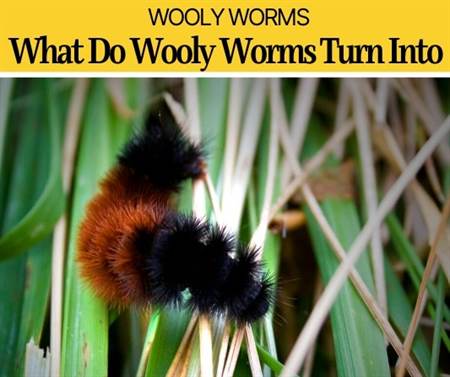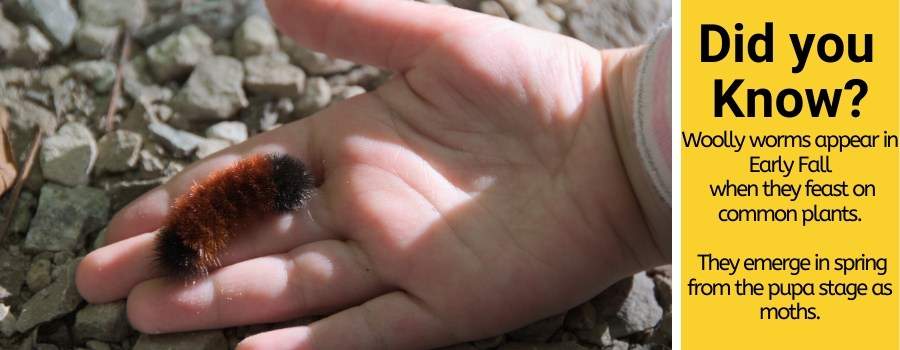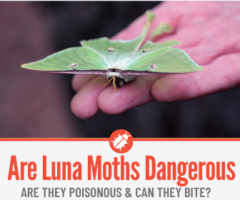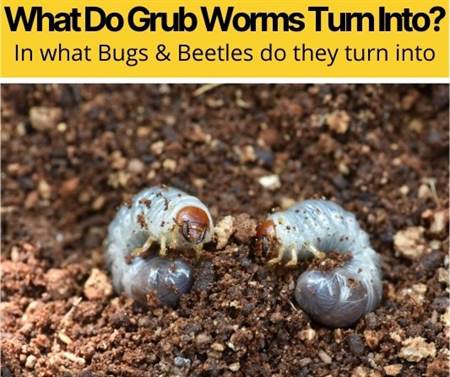 Hairy caterpillars can be quite amusing creatures to observe inching around your garden. While most species share the fussy hair and bright colors, each one will turn into a totally different insect.
Hairy caterpillars can be quite amusing creatures to observe inching around your garden. While most species share the fussy hair and bright colors, each one will turn into a totally different insect.
Woolly worms are without doubt one of the most popular hairy caterpillars in our daily lives, however, there are a lot of myths that surround them.
From the fact that they can predict the weather to how poisonous they can be,keep reading to uncover the truth behind most of those folkloric tales!
What Do Woolly Worms Turn Into?
One of the most common species crawling around is this hairy, black-and-orange fellow. These cheese puff-like creatures are named woolly worms or banded woolly bears and they belong to the Erebidae family. These larvae wooly worms will eventually turn into the Isabella Tiger moth or Pyrrharctia Isabella. You can identify these moths because of their dull yellow or tanned color; they have reddish forelegs, a furry thorax, and uneven black spots on its back. Their wingspan is of two inches.
Do wooly worms turn into moths
Yes, and unlike other caterpillars that turn just a few weeks after being hatched, woolly worms (also spelled wooly worms) will wait around six to seven months to turn into the Isabella tiger moth.
Banded woolly bears are most frequently seen during autumn, but in fact, there are two generations each year: one in May and one in August. While spring woolies spend most of their time eating, those woollies born in the fall have to search for shelter and resources to survive the winter—that is why it is so common to see them inching everywhere!
Woolly worms will take any dark and dry place to hibernate, something they can achieve thanks to the production of a chemical called cryoprotectant that protects the interior of their cells to prevent their tissue from freezing–Imagine how effective it is that these fussy guys have been found still alive, frozen inside an ice cube!
Banded woollies will remain hibernating until the weather is nice and warm around may, afterwards they will start eating again and prepare to pupate before the spring ends to develop into a full-grown Isabella tiger moth.
Related: Can you Eat Worms

Does a wooly worm turn into a butterfly
No. Woolly worms can only turn into tiger moths; in fact, almost all hairy caterpillars will turn into moths. While all caterpillars have hairs known as setae, there are some larvae with hair-like spines that will turn into different butterfly species.
Is it easy to confuse a moth and a butterfly, but there are a couple of clues that might help with that. Moths are usually active at night, while butterflies prefer sunlight; moths have feathery antennas and butterflies have some fire match-like ones. Another simple way to differentiate them is to observe their wings while resting: butterflies will hold their wings up, while moths fold their wings back.
Comparison Between Different Wooly Worms.
The fussy and furry body of the woolly worms gave them the nickname of woolly bears; this hair is a self-defense mechanism to scare predators away from eating them.
This furry characteristic is quite common in most larvae of the 11,000 moth species in the Arctiinae family, which includes the tiger moth, wasp moths, lichen moths, and footman moths. All these hairy caterpillars are known as woolly bears too! They all vary in color, abdominal segments, length, and bristles depending on the species.
The most popular (and common) is the banded woolly bear, which is the larva of the Isabella tiger moth, however, confusion between them and other wooly bears is understandable. In fact, there are at least eight other woolly bear species in the United States that share similar physical characteristics. Let’s explore three of the most common ones:
Yellow Wooly Bears , What do they Turn into?
The yellow woolly bear will turn into the Virginia tiger moth or Spilosoma virginica. These 13-segment caterpillars have a combination of short and long bristles; and they vary from a light cream to platinum blonde, caramel, chestnut, and even a cinnamon color. They can molt up to six times in a lifetime before turning into moths.
Yellow bears will be born during two cycles, the first one in May and the other one in August; but unlike the banded woolly bears, they will pupate during the winter to emerge in early spring.
The yellow bear will turn into a beautiful pure white moth with tiny black spots, on the contrary of other tiger moth species that have patterned wings and bodies. The males are smaller than the females and have a harrier body. The Virginia Tiger moth can be found in most United States, Central America, and the southern regions of Canada.
Black Wooly Worms,What do they Turn into?
Even if their common colors are black and orange, a banded woolly bear can also be a total black fellow and sometimes even fully brown (scroll down to see what this color variation means!) However, there is another popular black woolly bear caterpillar or giant woolly bear.
This would be the larva of the Giant Leopard Moth, also known as the Eye Tiger Moth. This 10-segment caterpillar is fully covered in shiny black bristles and tiny red spiracles but it also has dark brown and orange skin, usually visible underneath. Full-grown larvae will be around 3 inches long. Only one generation of black woollies will be born each year, although there can be two in southern areas. They will overwinter for almost 7 months–from August to May- until they are ready to become the largest moth species.
The eye tiger moth will have white wings with an attractive black pattern that simulates the one on the feline from their name, with a wingspan of almost 9 cm! The head and abdomen of these creatures can be bright orange with iridescent black and blue spotting. They are commonly found in Southern Ontario, Florida, and Texas.
White Wooly Worms , What do they Turn into?
The white woolly bear worm is the younger stage of the Hickory Tussock Moth. These pretty caterpillars are snow-white with black specs splattered around their body, covered in white and black setae. They also have four black overlong hairs called “pencils”, which gave them a terrible reputation because people thought they were connected to poisonous glands, still, experts say they only cause mild-irritation in non-sensitive skins.
A full-grown fuzzy fellow will be 4.5 centimeters long and will have only eight abdominal segments and they are most commonly found in Northeastern United States, Canada, and some regions in Texas and Mexico.
Only one generation is born each year around July and sticks around until early October when they will start spinning grey cocoons to spend the whole winter to emerge early spring. The female moth lays around 100 eggs, so the first days they will live in large clusters. Hickory Tussock Moths are identifiable because of their yellow/cream tones with orange and white shadings that create a hollowed-look pattern, and their wingspan is about 5.5 cm.
What Is A Woolly Worm
The fussy creatures are caterpillars that will turn into the Isabella tiger moths when they are around 6 months old. These one and half-inch animals are one of the 11,000 moth species that belong to the Arctiidae family.
Woolly worms, also known as banded woolly bears, are made of thirteen abdominal segments. The middle segments are covered in brown/orange bristles, while both ends are made of black hair. As a caterpillar matures, black bristles will be replaced with orange ones, shedding around 5 times in a lifetime. Appearances can be deceiving and even if they look dangerous, these spine-like hairs are not poisonous, but they can provoke irritation on the skin if touched.
These species will be around 2 inches long, have 6 lateral eyes arranged in a circle, short antennae, and a pair of legs in three of their thoracic segments. They also have some “fake legs” called abdominal prolegs, which help the larvae crawl in narrower spaces.
As a bonus fun fact, they will curl up and play dead whenever they feel threatened and they are famous in popular folklore because they are said to predict the weather with the color of their bristles.
What Do Woolly Worms Eat?
Woolly worms are herbivores, which means they will include all kinds of greens on their diets. These fuzzy animals will eat grasses, flowers, and plants.
These caterpillars will be looking for anything leafy and green, especially grasses, twigs, and grains, but they will also lurk on maple trees and elms for sweeter sources. When it comes to flowers and plants, woollies prefer violets, dandelions, clovers, nettles, and sunflowers.
Their water sources are the plant’s moisture, so they do not require any water to stay hydrated. On extreme occasions, woolly bears will survive out of fruit trees and garden plants such as spinach and cabbage. The Isabella tiger moth will hardly eat once and fly in search of a mate.
Where Do Wooly Worms Live?
The banded woolly bear is the most popular species across the United States, Canada, and some parts of Central America. These caterpillars prefer to live close to marshes and meadows but are very adaptable species, even an urban metropolis. During winter you can find them tucked under a tree log, leaf piles, or any other dry and dark space they can find.
What Does The Color Of Wooly Worms Mean
In reality, it means nothing asides from what experts think a level of maturity and nutrition. Depending on the age and nutrition a caterpillar follows, the black bristles will be replaced with colored ones as a sign of good health.
Nonetheless, you might have heard an urban legend that says the woolly bear caterpillar can predict the weather. The legend states that the color on these fussy worms can predict how severe the upcoming winter will be.
Woolly worms are made of 13 segments and go from dark black to rusty brown to many shades in between, but most normally they are dark on both ends with a brownish band in the middle; however, there can be occasions when they are just one full color.
Supposedly, the blacker a woolly worm is, the colder the winter will be; while more rusted color means a mild winter coming. It is also believed that since the insect is divided into the exact number of weeks that winter lasts, the number of black segments means the number of weeks that severe weather will last.
The legend started in 1948 after the curator of insects at the American Museum of Natural History published his findings on woolly caterpillars in the New York Herald. He was the first one to think the color on these fussy creatures could predict the weather.
What Do Fuzzy Brown And Black Caterpillars Eat
Most caterpillar species feed on a wide variety of plants, greens, legumes, fruits, and twigs. The specific food preferences can vary according to the species and habitats of each one.
Woolly worms are quite commonly called brown or black caterpillar because their feeding habits and age can affect their color directly. However, several types of fuzzy caterpillars can share the same name and color but belong to a whole different species.
For example, the Giant Leopard Moth larva or Black caterpillars are non-picky eaters and they will feed on a wide variety of greens and fruits. These creatures are nocturnal and are as likely to feed from the ground than from tree trunks. They have a particular preference for bananas, cherries, cabbages, oranges, sunflowers, violets, and maples.
As for brown caterpillars, one of the most common is the larva of the Fox moth. These caterpillar lives mainly on wetlands and feeds on heathers, brambles, and meadowsweets.
What Do Yellow Wooly Bear Caterpillars Eat
Yellow woolly bears prefer to hang out close to the ground, unlike other species that like to climb trees. That is why these larvae feed on many low-growing kinds of grass, herbs, and legumes. They have a particular fascination for cabbage, cloves, and tobacco.
These fussy caterpillars are defoliators, which means they will only eat the leafy or photosynthetic tissue of a plant. Defoliator insects can cause substantial damage to plants and are considered a pest. The yellow bears that are born before summer are considered being more voracious and aggressive with the damage they do to plants than the winter batch. The Virginia tiger moths change their menu to the sweet nectar from all sorts of flowers, specifically mints, solidago, daisies, and thistles.
How Long Does A Woolly Bear Caterpillar Live Before Turning?
Woolly bears have a very long lifespan of up to 14 years, although they rarely spend over a year in their larvae form. As soon as they reach adulthood, they will only survive for one or two weeks and will die 24 hours after laying their eggs.
The time they spend as caterpillars will most likely depend on the weather. Two generations are born every year, the first one in May and the other one in June or July.
The first generation will turn just before the summer ends because the climate is warmer and food is more available, but the second generation will overwinter and wait six to seven months to turn into the Isabella Tiger moth.
There is an amazing artic woolly bear caterpillar that lives in Northern Canada and the Northern Islands that takes up to seven years to pupate and turn into an adult moth! These caterpillars spend most of their lifetime frozen, trying to gather enough temperature and food to grow properly and eventually turn. When they finally do, they will only pupate for two weeks in summer and the adult moth will die right before summer ends.
Related Questions:
How does a wooly worm predict winter? The urban legend suggests that woolly worms can predict how harsh winter will be according to the width of their orange bristle band. Even if scientists have not been able to prove the accuracy of this theory, it states that the more orange hairs a woolly worm has, the less cold a winter will be. The more black bristles they have, the harsher it will be.
How Large is a baby woolly bear caterpillar? A newborn baby woolly bear caterpillar is the size of a pinhead, but a couple of weeks later they will be no longer than a fingernail long! For the first couple of weeks they will feed on the food plant their mother laid her eggs on until they can grow a little more to survive.






